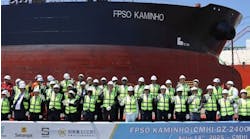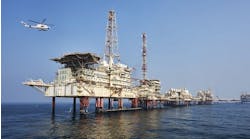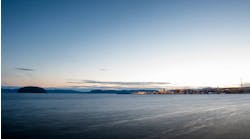Forecasting offshore activity is like forecasting the weather. Recently a paper reported doom and gloom as the Dow experienced a steep decline, crude oil prices took another dip, and several large operators warned of lower 4Q earnings. On the same day a press release reported that Shell had contracted four of Transocean's ultra-deepwater high-specification drilling units, the paper featured a story explaining how technology was sustaining natural gas drilling. As for the weather, at this writing the US is getting hit by a major cold front from the north, while from the south Hurricane Sandy is lashing Jamaica and taking aim at Cuba. These are interesting times.
Despite the apparent gloomy outlook featured in the daily press, the 2012 Society of Petroleum Engineers annual meeting in San Antonio attracted record crowds of delegates and exhibitors. Apparently they did not get the word as the atmosphere was decidedly upbeat. New technology tools and services were revealed in almost every sector from drilling to production and the technical program was full of technical success stories. The technical sessions the author attended were packed.
A typical reaction to tight margins in the industry is to roll up sleeves and develop innovative ways to perform the jobs more efficiently, improve production rates, boost ultimate recovery volumes, and generally improve profitability. Through technology, we expand our horizons, going after plays once considered undrillable, or reservoirs believed too tight to flow.
Three notable technologies
One of the most interesting new tools made its official debut at the SPE show. The Saturn 3D radial probe is an optional new module of the Schlumberger modular formation dynamics tester (MDT), which allows uncontaminated samples to be taken efficiently in extremely low permeability formations, unconsolidated formations, or low mobility heavy oil reservoirs.
Featuring four orthogonally phased probes mounted on an inflatable packer element, the tool delivers much higher flow rates than conventional probes in a radial flow regime so it can acquire uncontaminated formation fluid samples in a fraction of the time previously required. Representative samples and accurate formation pressure measurements can be obtained from formations once considered impractical or impossible to test.
Previous MDT modules can still be deployed with the new probe including the pump-out module, real-time downhole fluid analysis module, and multiple PVT sample chambers. Because the new probe is a stand-alone module, it can be run in conjunction with a standard probe and only switched over as required by command from the surface while the tool is in the hole. Because the four elliptical probes are seated in the packer element itself, acquiring and maintaining a good seal is much easier, even in a rugose or oval hole. Each probe has slightly less than 20-sq in. flow area.
A small company with a famous name exhibited innovative sand management media. Darcy Technologies of Aberdeen, Scotland, showed its all steel expandable sand screen. Part of the company's Critical Matrix Management offering, the technology recognizes that formations sand because of changes in the rock stress profile that holds the sand grains in place. Using its expandable media to maintain critical stress profiles in the surrounding matrix during production controls sanding, channels reservoir fluids, isolates flow, and boosts completion permeability. The screens are compatible with inflow control device technology and formation isolation valves, and because they are expanded by integral expansion ducts, the through-bore is maintained so the isolation completion can be run in after the screens are set.
Since deeper, hotter wells are being constructed, high-temperature drilling fluids are needed to drill them. M-I SWACO exhibited its Rhadiant non-aqueous fluid system that can maintain its thermal stability in wells whose bottomhole temperature exceeds 500°F (260°C). Featuring new emulsifier technology that delivers lower, non-progressive gel strengths, lower surge and swab pressures, and ultra-thin slick filter cake, the new fluid effectively controls equivalent circulating densities and reduces torque and drag, mud loss, or stuck pipe incidents. Ballooning, typically associated with deep hot wellbores, is minimized. The fluid also maintains its properties during long static periods while the rig is logging, cementing, or tripping pipe.
These new technologies are but three of many innovative ideas on display at the exhibition and described in the technical sessions. Each technology epitomized the theme of this year's annual meeting—unconventional wisdom.
Unlike activity and the weather, one thing that never changes is that evolving technology remains the critical factor in sustaining the industry's leadership in providing energy for the future. In every facet of exploration, drilling, completion, and production the industry is accomplishing feats that were unthinkable only a few years ago. Any forecasted activity will be heavily influenced by demand, technical capability and an inspired, experienced workforce. All three are evident today.
First gravel pack multi-lateral in place offshore Brazil
Statoil has completed its first multi-lateral well offshore Brazil on the Peregrino field. The company claims this is the country's first multi-lateral with gravel pack in both branches.
Peregrino is a heavy oil field with strong potential for increased recovery. It holds in-place oil volumes of 2.3 Bbbl, in addition to resources at the Peregrino South discovery. But, its recovery factor remains low compared to conventional oil fields.
Through various measures Statoil has doubled the expected recovery factor to about 20%. The main issues it has addressed include a high degree of reservoir exposure, drilling of long horizontal wells (15 producers to date) with geosteering technology to maximize length and optimize placement, and water injection to improve oil recovery. The combination of produced water injection, horizontal wells, and flow assurance has so far increased estimated recoverable resources to 300-600 MMbbl.
Peregrino has two drilling and wellhead platforms and a large FPSO. The field is 85 km (53 mi) offshore Brazil in the Campos basin in about 100 m (328 ft) of water in licenses BM-C-7 and BM-C-47.
Over the past few years Statoil has introduced multi-lateral well technology to several fields offshore Norway.





